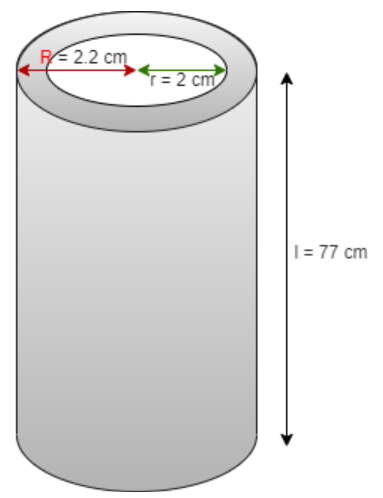
A metal pipe is 77 cm long. The inner diameter of a cross-section is 4 cm, the outer diameter being 4.4 cm (see figure). Find its
(i). Inner curved surface area
(ii). Outer curved surface area
(iii). Total surface area
Answer
471.9k+ views
Hint: To solve this question one should have knowledge of shapes and also remember that Inner curved surface area =$2\pi rl$, where r is inner radius and curved surface area =$2\pi Rl$, where R is the outer radius.
Complete step-by-step solution
And total surface area of a hollow cylindrical pipe =$2\pi (R + r)(R - r + h)$, where h is the height or length of the pipe.
According to question, length of cylindrical pipe = 77cm
Since, Inner diameter = 4cm
Therefore, Inner radius = $\dfrac{4}{2} = 2cm$
Also, Outer diameter is given = 4.4cm
So, Outer radius = $\dfrac{{4.4cm}}{2} = 2.2cm$

We know that formula of Inner curved surface area = $2\pi rl$ here r is the inner radius and l is the length of the metal pipe
So, substituting the values in the above formula, we get
Inner curved surface area = $2 \times \dfrac{{22}}{7} \times 2 \times 77 = 968c{m^2}$
Also, we know that formula of Outer curved surface area = $2\pi Rl$ here R is the outer radius and l is the length of the metal pipe
Now substituting the values in the above formula, we get
Outer curved surface area = $2 \times \dfrac{{22}}{7} \times 2.2 \times 77 = 1064.8c{m^2}$
So, to find the Total surface area which is equal to inner surface area of metal pipe + outer surface area of metal pipe + surface area of both bases
And we know that surface area of base can be found as; area of outer circle – area of inner circle
And we know that area of circle is equal to $\pi {r^2}$here r is the radius
Therefore, surface area of base = \[\pi {R^2} - \pi {r^2}\]
So, Total surface area = $2\pi (R + r)(R - r + h)$
Now substituting the values in the above formula, we get
Total surface area = $2 \times \dfrac{{22}}{7}(2.2 + 2)(2.2 - 2 + 77)c{m^2}$= $\dfrac{{44}}{7} \times 4.2 \times 77.2c{m^2} = 2038.08c{m^2}$
(i). Hence, Inner curved surface area = $968c{m^2}$
(ii). Outer curved surface area = $1064.8c{m^2}$
(iii). And, total surface area = $2038.08c{m^2}$
Note: Total surface area can also be calculated by adding inner curved surface area, outer curved surface, and twice the area of the concentric circle which was formed by outer radius and inner radius. Area of concentric circle =$\pi {R^2} - \pi {r^2}$, where R = radius of outer circle and r = radius of inner circle.
Complete step-by-step solution
And total surface area of a hollow cylindrical pipe =$2\pi (R + r)(R - r + h)$, where h is the height or length of the pipe.
According to question, length of cylindrical pipe = 77cm
Since, Inner diameter = 4cm
Therefore, Inner radius = $\dfrac{4}{2} = 2cm$
Also, Outer diameter is given = 4.4cm
So, Outer radius = $\dfrac{{4.4cm}}{2} = 2.2cm$

We know that formula of Inner curved surface area = $2\pi rl$ here r is the inner radius and l is the length of the metal pipe
So, substituting the values in the above formula, we get
Inner curved surface area = $2 \times \dfrac{{22}}{7} \times 2 \times 77 = 968c{m^2}$
Also, we know that formula of Outer curved surface area = $2\pi Rl$ here R is the outer radius and l is the length of the metal pipe
Now substituting the values in the above formula, we get
Outer curved surface area = $2 \times \dfrac{{22}}{7} \times 2.2 \times 77 = 1064.8c{m^2}$
So, to find the Total surface area which is equal to inner surface area of metal pipe + outer surface area of metal pipe + surface area of both bases
And we know that surface area of base can be found as; area of outer circle – area of inner circle
And we know that area of circle is equal to $\pi {r^2}$here r is the radius
Therefore, surface area of base = \[\pi {R^2} - \pi {r^2}\]
So, Total surface area = $2\pi (R + r)(R - r + h)$
Now substituting the values in the above formula, we get
Total surface area = $2 \times \dfrac{{22}}{7}(2.2 + 2)(2.2 - 2 + 77)c{m^2}$= $\dfrac{{44}}{7} \times 4.2 \times 77.2c{m^2} = 2038.08c{m^2}$
(i). Hence, Inner curved surface area = $968c{m^2}$
(ii). Outer curved surface area = $1064.8c{m^2}$
(iii). And, total surface area = $2038.08c{m^2}$
Note: Total surface area can also be calculated by adding inner curved surface area, outer curved surface, and twice the area of the concentric circle which was formed by outer radius and inner radius. Area of concentric circle =$\pi {R^2} - \pi {r^2}$, where R = radius of outer circle and r = radius of inner circle.
Recently Updated Pages
Master Class 9 General Knowledge: Engaging Questions & Answers for Success

Master Class 9 English: Engaging Questions & Answers for Success

Master Class 9 Science: Engaging Questions & Answers for Success

Master Class 9 Social Science: Engaging Questions & Answers for Success

Master Class 9 Maths: Engaging Questions & Answers for Success

Class 9 Question and Answer - Your Ultimate Solutions Guide

Trending doubts
Fill the blanks with the suitable prepositions 1 The class 9 english CBSE

How do you graph the function fx 4x class 9 maths CBSE

Name the states which share their boundary with Indias class 9 social science CBSE

Difference Between Plant Cell and Animal Cell

What is pollution? How many types of pollution? Define it

What is the color of ferrous sulphate crystals? How does this color change after heating? Name the products formed on strongly heating ferrous sulphate crystals. What type of chemical reaction occurs in this type of change.




